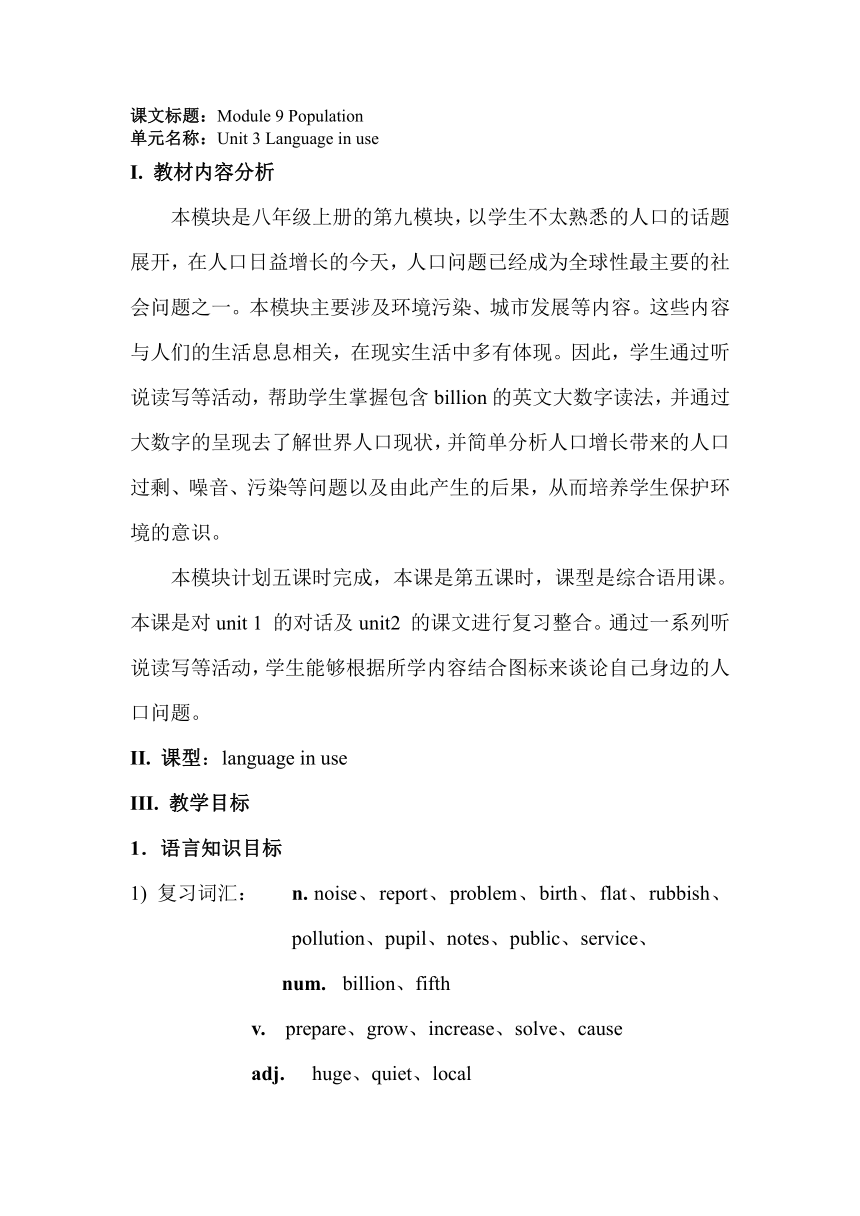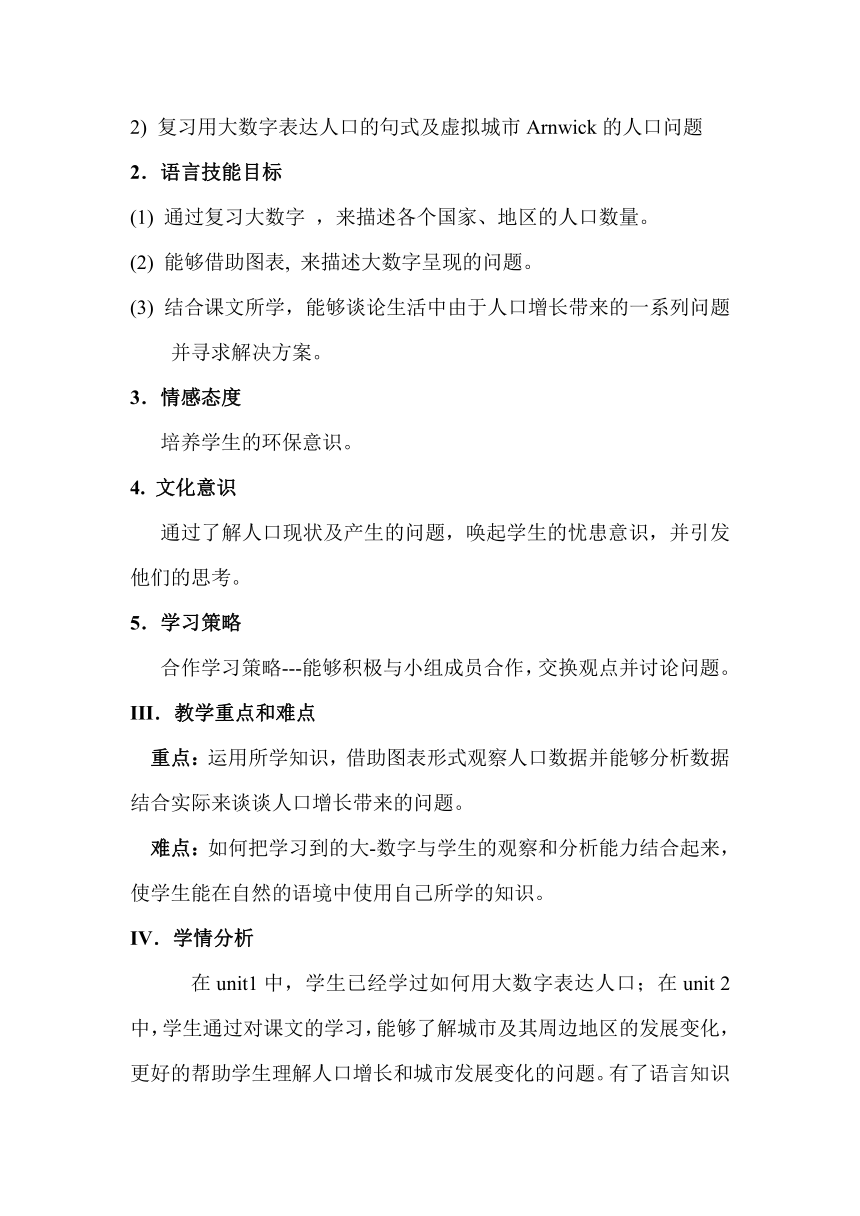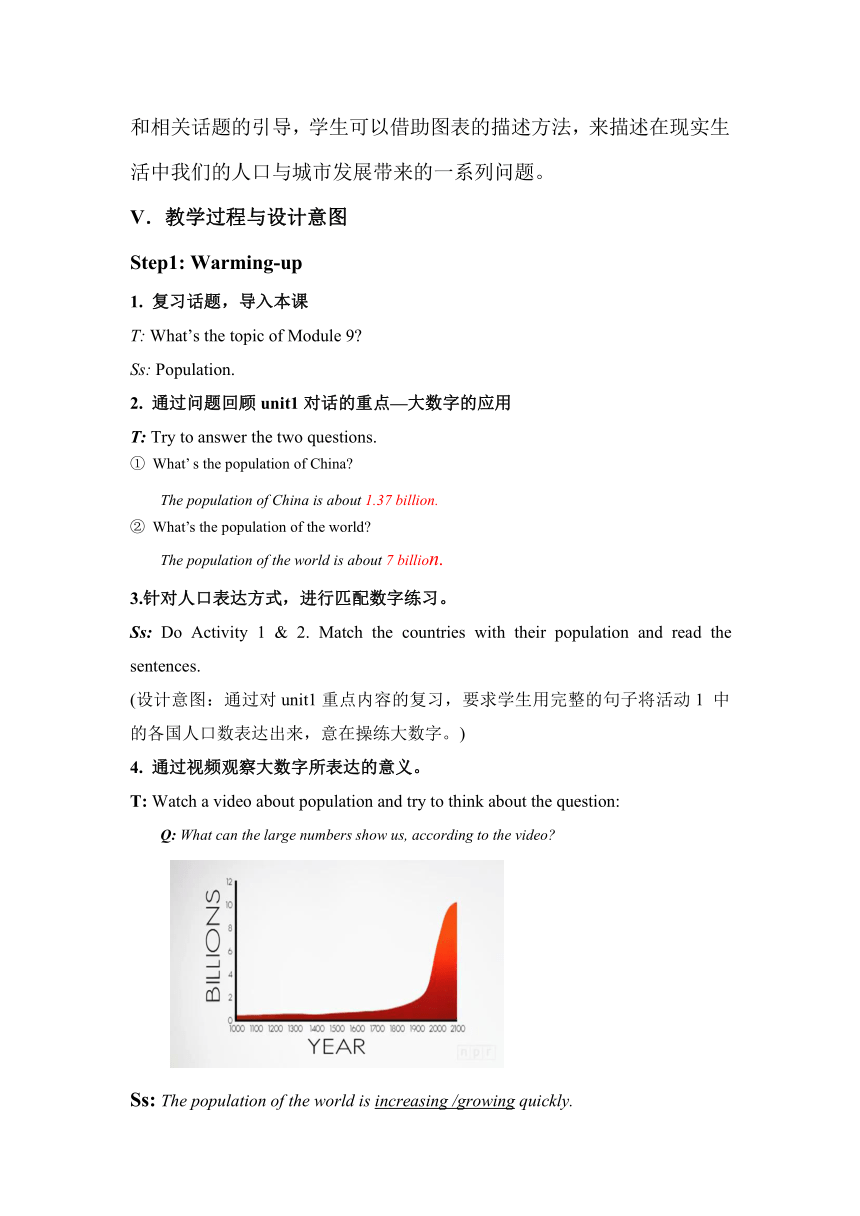Module 9 Unit 3 Language in use 教案
文档属性
| 名称 | Module 9 Unit 3 Language in use 教案 |

|
|
| 格式 | doc | ||
| 文件大小 | 268.5KB | ||
| 资源类型 | 教案 | ||
| 版本资源 | 外研版 | ||
| 科目 | 英语 | ||
| 更新时间 | 2022-12-06 09:15:36 | ||
图片预览



文档简介
课文标题:Module 9 Population
单元名称:Unit 3 Language in use
I. 教材内容分析
本模块是八年级上册的第九模块,以学生不太熟悉的人口的话题展开,在人口日益增长的今天,人口问题已经成为全球性最主要的社会问题之一。本模块主要涉及环境污染、城市发展等内容。这些内容与人们的生活息息相关,在现实生活中多有体现。因此,学生通过听说读写等活动,帮助学生掌握包含billion的英文大数字读法,并通过大数字的呈现去了解世界人口现状,并简单分析人口增长带来的人口过剩、噪音、污染等问题以及由此产生的后果,从而培养学生保护环境的意识。
本模块计划五课时完成,本课是第五课时,课型是综合语用课。本课是对unit 1 的对话及unit2 的课文进行复习整合。通过一系列听说读写等活动,学生能够根据所学内容结合图标来谈论自己身边的人口问题。
II. 课型:language in use
III. 教学目标
1.语言知识目标
1) 复习词汇: n. noise、report、problem、birth、flat、rubbish、pollution、pupil、notes、public、service、
num. billion、fifth
v. prepare、grow、increase、solve、cause
adj. huge、quiet、local
2) 复习用大数字表达人口的句式及虚拟城市Arnwick的人口问题
2.语言技能目标
(1) 通过复习大数字 ,来描述各个国家、地区的人口数量。
(2) 能够借助图表, 来描述大数字呈现的问题。
(3) 结合课文所学,能够谈论生活中由于人口增长带来的一系列问题并寻求解决方案。
3.情感态度
培养学生的环保意识。
4. 文化意识
通过了解人口现状及产生的问题,唤起学生的忧患意识,并引发他们的思考。
5.学习策略
合作学习策略---能够积极与小组成员合作,交换观点并讨论问题。
III.教学重点和难点
重点:运用所学知识,借助图表形式观察人口数据并能够分析数据结合实际来谈谈人口增长带来的问题。
难点:如何把学习到的大-数字与学生的观察和分析能力结合起来,使学生能在自然的语境中使用自己所学的知识。
IV.学情分析
在unit1中,学生已经学过如何用大数字表达人口;在unit 2 中,学生通过对课文的学习,能够了解城市及其周边地区的发展变化,更好的帮助学生理解人口增长和城市发展变化的问题。有了语言知识和相关话题的引导,学生可以借助图表的描述方法,来描述在现实生活中我们的人口与城市发展带来的一系列问题。
V.教学过程与设计意图
Step1: Warming-up
1. 复习话题,导入本课
T: What’s the topic of Module 9
Ss: Population.
2. 通过问题回顾unit1对话的重点—大数字的应用
T: Try to answer the two questions.
① What’ s the population of China
The population of China is about 1.37 billion.
② What’s the population of the world
The population of the world is about 7 billion.
3.针对人口表达方式,进行匹配数字练习。
Ss: Do Activity 1 & 2. Match the countries with their population and read the sentences.
(设计意图:通过对unit1重点内容的复习,要求学生用完整的句子将活动1 中的各国人口数表达出来,意在操练大数字。)
4. 通过视频观察大数字所表达的意义。
T: Watch a video about population and try to think about the question:
Q: What can the large numbers show us, according to the video
Ss: The population of the world is increasing /growing quickly.
5. 回顾unit2课文,复习关于人口问题的重点词汇。
T: What can the increasing population bring us
Try to finish the short passage according to unit 2.
Ss: Choose the correct words
expensive flat crowded rubbish traffic pollution service
Arnwick was a small city with 200,000 people before. People from village moved to Arnwick to find jobs and they need places to live. Now the population of Arnwick is about one million.
However, it was____ expensive____ to live in the city center. So the government built ____flats____ outside the center. But it’s very ____crowded____ and _____rubbish______ is everywhere.
Every day Jo needs to spend an hour to go to school by bus. So there is lots of _____traffic______ and ____pollution______. With the increasing population, Arnwick needs better public ___services___, such as schools, buses and hospitals.
6. 通过回顾课文,思考人口增长带来的问题。
T: After review the passage about Arnwick, let’s think about these questions.
Q1: What is the population of Arnwick now
Q2:Has the population of Arnwick changed these years?
Q3: What can the increasing population bring to Arnwick
Ss: Discuss the questions in groups.
A1:The population of Arnwick is about one million
A2: Yes. The population of Arnwick is increasing.
A3: The increasing population of Arnwick causes lots of problems.
Such as expensive flats/ too much traffic/ too much population…
(设计意图:通过匹配练习,课文填空及回答问题的形式帮助同学们复习模块多学的重点内容,为下文输出练习做铺垫。)
Step 2: Learning to learn
1. 借助图表,分析数字及数字表达的意义。
T: Sometimes we can use a picture, a video or a chart to help us learn some important or difficult things. Now, try to answer the questions to learn about the population of other cities
Ss: Do Activity 3. Read the chart and answer the questions.
Q1: What was the population of New York in 2000
Q2: Compared the population in 2000 with the population in 2025, what can you learn from the numbers
Q3: Do you think Tokyo will have the biggest population problem why
Q4: Do you have different ideas
Ss: Do the practice and then discuss in groups.
A1:The population of New York was 17.8 million.
A2:The population of each city is increasing. And some of them are increasing faster.
A3: Yes. Because Tokyo will have the largest population in 2025.
A4: Mumbai also has the biggest population problem. Because its population will increase the most in 2025.
(设计意图:将具体的数字图示化,帮助学生更好理解、分析数字背后所表达的事实及意义。)
Step3: Talk about our hometown---Dalian
T: Dalian is our hometown and it is developing quickly these years.
Now, would you like to talk about the population of Dalian in groups with the help of the chart. Try to use what we have learnt in unit 1 and unit 2.
Ss: Discuss in groups and try to share different ideas with partners.
(设计意图:通过复习unit1 和unit2 的内容,并将所有的内容联系到一起,来谈论学生身边的实际问题,结合图表,小组分享在现实生活当中,人口增长带来的实际生活问题。)
Step 4 Homework
T: When we find out there are some population problems of Dalian, as a member of Dalian , we need to do something to solve the problems. If we can’t solve them, we can give advice to the government.
Homework:
Try to find some ways to solve the problems on the Internet
Give some advice to the government to solve the problems.
Choose one of them.
(通过对人口问题的分析,帮助学生们提高环境意识,借助网络寻找解决的办法,从而提高学生们保护、热爱我们的家园的情感意识。)
单元名称:Unit 3 Language in use
I. 教材内容分析
本模块是八年级上册的第九模块,以学生不太熟悉的人口的话题展开,在人口日益增长的今天,人口问题已经成为全球性最主要的社会问题之一。本模块主要涉及环境污染、城市发展等内容。这些内容与人们的生活息息相关,在现实生活中多有体现。因此,学生通过听说读写等活动,帮助学生掌握包含billion的英文大数字读法,并通过大数字的呈现去了解世界人口现状,并简单分析人口增长带来的人口过剩、噪音、污染等问题以及由此产生的后果,从而培养学生保护环境的意识。
本模块计划五课时完成,本课是第五课时,课型是综合语用课。本课是对unit 1 的对话及unit2 的课文进行复习整合。通过一系列听说读写等活动,学生能够根据所学内容结合图标来谈论自己身边的人口问题。
II. 课型:language in use
III. 教学目标
1.语言知识目标
1) 复习词汇: n. noise、report、problem、birth、flat、rubbish、pollution、pupil、notes、public、service、
num. billion、fifth
v. prepare、grow、increase、solve、cause
adj. huge、quiet、local
2) 复习用大数字表达人口的句式及虚拟城市Arnwick的人口问题
2.语言技能目标
(1) 通过复习大数字 ,来描述各个国家、地区的人口数量。
(2) 能够借助图表, 来描述大数字呈现的问题。
(3) 结合课文所学,能够谈论生活中由于人口增长带来的一系列问题并寻求解决方案。
3.情感态度
培养学生的环保意识。
4. 文化意识
通过了解人口现状及产生的问题,唤起学生的忧患意识,并引发他们的思考。
5.学习策略
合作学习策略---能够积极与小组成员合作,交换观点并讨论问题。
III.教学重点和难点
重点:运用所学知识,借助图表形式观察人口数据并能够分析数据结合实际来谈谈人口增长带来的问题。
难点:如何把学习到的大-数字与学生的观察和分析能力结合起来,使学生能在自然的语境中使用自己所学的知识。
IV.学情分析
在unit1中,学生已经学过如何用大数字表达人口;在unit 2 中,学生通过对课文的学习,能够了解城市及其周边地区的发展变化,更好的帮助学生理解人口增长和城市发展变化的问题。有了语言知识和相关话题的引导,学生可以借助图表的描述方法,来描述在现实生活中我们的人口与城市发展带来的一系列问题。
V.教学过程与设计意图
Step1: Warming-up
1. 复习话题,导入本课
T: What’s the topic of Module 9
Ss: Population.
2. 通过问题回顾unit1对话的重点—大数字的应用
T: Try to answer the two questions.
① What’ s the population of China
The population of China is about 1.37 billion.
② What’s the population of the world
The population of the world is about 7 billion.
3.针对人口表达方式,进行匹配数字练习。
Ss: Do Activity 1 & 2. Match the countries with their population and read the sentences.
(设计意图:通过对unit1重点内容的复习,要求学生用完整的句子将活动1 中的各国人口数表达出来,意在操练大数字。)
4. 通过视频观察大数字所表达的意义。
T: Watch a video about population and try to think about the question:
Q: What can the large numbers show us, according to the video
Ss: The population of the world is increasing /growing quickly.
5. 回顾unit2课文,复习关于人口问题的重点词汇。
T: What can the increasing population bring us
Try to finish the short passage according to unit 2.
Ss: Choose the correct words
expensive flat crowded rubbish traffic pollution service
Arnwick was a small city with 200,000 people before. People from village moved to Arnwick to find jobs and they need places to live. Now the population of Arnwick is about one million.
However, it was____ expensive____ to live in the city center. So the government built ____flats____ outside the center. But it’s very ____crowded____ and _____rubbish______ is everywhere.
Every day Jo needs to spend an hour to go to school by bus. So there is lots of _____traffic______ and ____pollution______. With the increasing population, Arnwick needs better public ___services___, such as schools, buses and hospitals.
6. 通过回顾课文,思考人口增长带来的问题。
T: After review the passage about Arnwick, let’s think about these questions.
Q1: What is the population of Arnwick now
Q2:Has the population of Arnwick changed these years?
Q3: What can the increasing population bring to Arnwick
Ss: Discuss the questions in groups.
A1:The population of Arnwick is about one million
A2: Yes. The population of Arnwick is increasing.
A3: The increasing population of Arnwick causes lots of problems.
Such as expensive flats/ too much traffic/ too much population…
(设计意图:通过匹配练习,课文填空及回答问题的形式帮助同学们复习模块多学的重点内容,为下文输出练习做铺垫。)
Step 2: Learning to learn
1. 借助图表,分析数字及数字表达的意义。
T: Sometimes we can use a picture, a video or a chart to help us learn some important or difficult things. Now, try to answer the questions to learn about the population of other cities
Ss: Do Activity 3. Read the chart and answer the questions.
Q1: What was the population of New York in 2000
Q2: Compared the population in 2000 with the population in 2025, what can you learn from the numbers
Q3: Do you think Tokyo will have the biggest population problem why
Q4: Do you have different ideas
Ss: Do the practice and then discuss in groups.
A1:The population of New York was 17.8 million.
A2:The population of each city is increasing. And some of them are increasing faster.
A3: Yes. Because Tokyo will have the largest population in 2025.
A4: Mumbai also has the biggest population problem. Because its population will increase the most in 2025.
(设计意图:将具体的数字图示化,帮助学生更好理解、分析数字背后所表达的事实及意义。)
Step3: Talk about our hometown---Dalian
T: Dalian is our hometown and it is developing quickly these years.
Now, would you like to talk about the population of Dalian in groups with the help of the chart. Try to use what we have learnt in unit 1 and unit 2.
Ss: Discuss in groups and try to share different ideas with partners.
(设计意图:通过复习unit1 和unit2 的内容,并将所有的内容联系到一起,来谈论学生身边的实际问题,结合图表,小组分享在现实生活当中,人口增长带来的实际生活问题。)
Step 4 Homework
T: When we find out there are some population problems of Dalian, as a member of Dalian , we need to do something to solve the problems. If we can’t solve them, we can give advice to the government.
Homework:
Try to find some ways to solve the problems on the Internet
Give some advice to the government to solve the problems.
Choose one of them.
(通过对人口问题的分析,帮助学生们提高环境意识,借助网络寻找解决的办法,从而提高学生们保护、热爱我们的家园的情感意识。)
同课章节目录
- Module 1 How to learn English
- Unit 1 Let's try to speak English as much as possi
- Unit 2 You should smile at her.
- Unit 3 Language in use .
- Module 2 My home town and my country
- Unit 1 It's taller than many other buildings.
- Unit 2 Cambridge is a beautiful city in the east o
- Unit 3 Language in use .
- Module 3 Sports.
- Unit 1 Nothing is more exciting than playing tenni
- Unit 2 This year we training more carefully.
- Unit 3 Language in use .
- Module 4 Planes, ships and trains .
- Unit 1 He lives the farthest from school.
- Unit 2 What is the best way to travel.
- Unit 3 Language in use .
- Module 5 Lao She Teahouse.
- Unit 1 I wanted to see the Beijing Opera.
- Unit 2 It descibes the changes in Chinese society.
- Unit 3 Language in use .
- Module 6 Animals in danger.
- Unit 1 It allows people to get closer to them .
- Unit 2 The WWF is working hard to save them all.
- Unit 3 Language in use .
- Revision module A
- Module 7 A famous story
- Unit 1 Alice was sitting with her sister by the ri
- Unit 2 She was thinking about her cat.
- Unit 3 Language in use .
- Module 8 Accidents
- Unit 1 While the car were changing to red, a car s
- Unit 2 I was trying to pick it up when it bite me
- Unit 3 Language in use .
- Module 9 Population
- Unit 1 The population of China is about 1.37 billi
- Unit 2 Arnwick was a city with 200,000 people.
- Unit 3 Language in use .
- Module 10 The weathe
- Unit 1 It might snow.
- Unit 2 The weather is fine all year round.
- Unit 3 Language in use .
- Module 11 Way of life
- Unit 1 In China ,we open a gift later.
- Unit 2 In England, you usually drink tea with milk
- Unit 3 Language in use .
- Module 12 Help
- Unit 1 What should we do before help arrives?
- Unit 2 Stay away from windows and heavy furniture.
- Unit 3 Language in use .
- Revision module B
